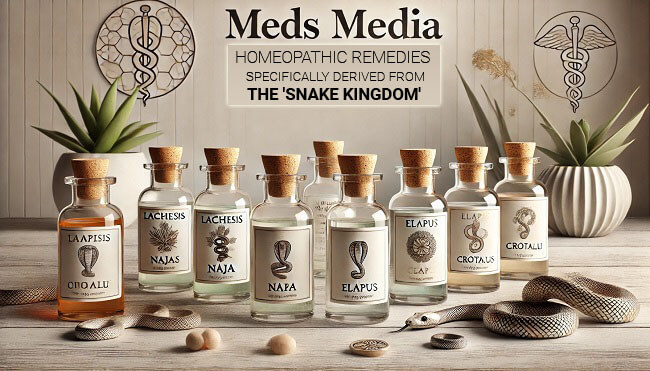Homeopathy derives remedies from a wide array of natural substances, including minerals, plants, and even animals. One of the fascinating aspects of homeopathic medicine is the use of snake venoms to create remedies that can address a variety of physical, mental, and emotional ailments. These remedies are derived from the Snake Kingdom, which encompasses a range of species, each with its unique therapeutic benefits. Snake venoms are highly potent and when prepared homeopathically, they can act on the human body to heal specific symptoms and conditions.
In homeopathy, snake remedies are often prescribed for conditions that involve blood, the cardiovascular system, neurological issues, and emotional disturbances such as fear, anxiety, and paranoia. Snake venoms tend to act deeply on the organism and are frequently used in chronic, acute, and severe conditions, depending on the remedy and the individual case.
How Snake Kingdom Remedies Work
Snake remedies in homeopathy are made by potentizing snake venom through a process of serial dilution and succussion (vigorous shaking). This process removes the toxic effects of the venom while preserving its healing properties. Homeopathically prepared snake venoms stimulate the body’s innate healing capacity, often focusing on symptoms related to blood clotting, bleeding disorders, neurological problems, and emotional issues.
Key Remedies Derived from the Snake Kingdom
1. Bitis arietans (Puff Adder)
- Main Indication: Circulatory issues and blood coagulation disorders.
- Main Symptoms: Bruising, blood clots, varicose veins, and thrombosis. Severe pain in the veins.
- Uses: Effective for people suffering from deep vein thrombosis, chronic venous insufficiency, or conditions where blood is stagnant and tends to clot.
- Suitability: Chronic, Severe.
2. Boa Constrictor
- Main Indication: Muscular pain, sensation of constriction.
- Main Symptoms: Tightness or constricting sensations around the chest or other parts of the body. Muscular weakness, especially in the arms and legs.
- Uses: For patients who feel as though their muscles or chest are being squeezed. Useful in cases of asthma or muscular dystrophy.
- Suitability: Chronic, Acute.
3. Bothrops atrox (Common Lancehead)
- Main Indication: Hemorrhagic conditions and circulatory disorders.
- Main Symptoms: Tendency to bleed easily, stroke, and paralysis on one side of the body.
- Uses: Useful in preventing strokes or dealing with the aftermath, especially when there’s paralysis and difficulty speaking.
- Suitability: Severe, Chronic.
4. Bothrops lanceolatus (Martinican Pit Viper)
- Main Indication: Thrombosis and circulatory problems.
- Main Symptoms: Blood clotting issues, varicose veins, and swollen, painful limbs.
- Uses: Applied for venous insufficiency, where the limbs are swollen and painful due to poor circulation.
- Suitability: Severe, Chronic.
5. Bungarus Fasciatus (Striped Bungarus)
- Main Indication: Neurological disorders and paralysis.
- Main Symptoms: Progressive paralysis, especially affecting the muscles of the face and extremities. Difficulty speaking and swallowing.
- Uses: Excellent for treating paralysis and neurological issues, particularly those that progress from the lower limbs upwards.
- Suitability: Severe, Chronic.
6. Cenchris contortrix (Southern Copperhead Snake)
- Main Indication: Psychological issues, including delusions and paranoia.
- Main Symptoms: Sudden mood changes, fear of impending doom, and paranoid delusions. Sensation of being constricted or suffocated.
- Uses: Beneficial for individuals with deep-seated emotional issues, including paranoia, anxiety, and depression.
- Suitability: Chronic.
7. Crotalus cascavella (Brazilian Rattlesnake)
- Main Indication: Blood poisoning and liver problems.
- Main Symptoms: Jaundice, septicemia, and hemorrhaging. Intense nausea and vomiting of bile.
- Uses: Used to treat septicemia, jaundice, and conditions involving liver dysfunction and blood toxicity.
- Suitability: Severe, Chronic.
8. Crotalus horridus (Timber Rattlesnake)
- Main Indication: Hemorrhagic fevers and blood disorders.
- Main Symptoms: Bleeding from various orifices, difficulty clotting, and rapid destruction of red blood cells.
- Uses: Effective for hemorrhagic fevers, sepsis, and other severe blood-related disorders.
- Suitability: Severe, Chronic.
9. Dendroaspis polylepsis (Black Mamba)
- Main Indication: Neurological disorders, especially those involving rapid onset.
- Main Symptoms: Extreme anxiety, restlessness, and muscle twitches progressing to paralysis.
- Uses: Treats neurological conditions that progress rapidly, such as multiple sclerosis or other degenerative nerve disorders.
- Suitability: Severe, Acute.
10. Elaps corallinus (Coral Snake)
- Main Indication: Ear and throat issues.
- Main Symptoms: Intense ear pain, ringing in the ears, and throat pain.
- Uses: Especially effective for sharp, stabbing pains in the ears or throat infections accompanied by bleeding.
- Suitability: Acute, Chronic.
11. Eunectes Murinus (Green Anaconda)
- Note: This remedy is less well-known and not widely used compared to more established snake venom remedies.
- Main Indication: Respiratory and circulatory problems.
- Main Symptoms: Constriction in the chest, difficulty breathing, and sluggish circulation.
- Uses: Used for treating asthma, respiratory constriction, and poor circulation, especially in the elderly.
- Suitability: Chronic.
12. Habu Snake (Trimeresurus flavoviridis)
- Note: Although it has medicinal potential, it’s not as frequently utilized as other snake remedies.
- Main Indication: Eye disorders and blood clotting issues.
- Main Symptoms: Hemorrhaging in the retina, vision problems, and clotting disorders.
- Uses: Ideal for individuals suffering from retinal hemorrhages or vision loss due to blood clots in the eye.
- Suitability: Chronic, Severe.
13. Hydrophis cyanocinctus (Blue-banded Sea Snake)
- Main Indication: Paralysis and muscular degeneration.
- Main Symptoms: Weakness in muscles, paralysis, and difficulty breathing due to respiratory muscle weakness.
- Uses: Best for muscular dystrophy and conditions that involve muscle degeneration or respiratory paralysis.
- Suitability: Severe, Chronic.
14. Lachesis Trigonocephalus (Bushmaster Surukuku Snake)
- Main Indication: Circulatory and hormonal issues.
- Main Symptoms: Hot flashes, especially during menopause, feelings of constriction, and intolerance to tight clothing.
- Uses: Particularly helpful for menopausal women with circulatory issues or hormonal imbalances, including hot flashes and headaches.
- Suitability: Chronic.
15. Naja Tripudians (Venom of Cobra)
- Main Indication: Heart issues and respiratory disorders.
- Main Symptoms: Palpitations, chest pain, shortness of breath, and a dry cough.
- Uses: Commonly used for angina, asthma, and conditions involving the heart and respiratory systems.
- Suitability: Acute, Chronic.
16. Natrix natrix (Grass Snake)
- Main Indication: Skin issues and respiratory problems.
- Main Symptoms: Itching, dryness of the skin, and cough with mucus production.
- Uses: For individuals suffering from eczema, dry skin, and respiratory issues like bronchitis.
- Suitability: Acute, Chronic.
17. Oxyuranus microlepidotus (Inland Taipan)
- Main Indication: Severe neurological and circulatory disorders.
- Main Symptoms: Paralysis, stroke-like symptoms, and blood clotting issues.
- Uses: Especially useful for stroke recovery and severe neurological conditions with clotting abnormalities.
- Suitability: Severe.
18. Python (Indian) Excrementum (Indian Python)
- Main Indication: Digestive disorders and toxicity.
- Main Symptoms: Constipation, sluggish digestion, and symptoms of toxicity.
- Uses: Beneficial for detoxifying the body and improving sluggish digestion.
- Suitability: Chronic, Acute.
19. Python regius (King Python)
- Note: While used in some homeopathic circles, it’s not as common as remedies like Lachesis or Crotalus horridus.
- Main Indication: Circulatory and digestive problems.
- Main Symptoms: Poor circulation, varicose veins, and bloating after meals.
- Uses: Ideal for those with slow digestion and poor circulation, especially in the legs.
- Suitability: Chronic.
20. Toxicophis pugnax (Agkistrodon Piscivorus Piscivorus)
- Main Indication: Inflammatory conditions.
- Main Symptoms: Inflammation of the skin, joints, and organs.
- Uses: Used to treat conditions involving inflammation such as arthritis or skin eruptions.
- Suitability: Chronic, Severe.
21. Vipera aspis (European Viper)
- Main Indication: Venous insufficiency and circulatory disorders.
- Main Symptoms: Severe pain in veins, swollen limbs, blue discoloration of the skin, varicose veins, and thrombosis.
- Uses: Particularly useful for treating varicose veins, phlebitis (vein inflammation), deep vein thrombosis (DVT), and venous ulcers. Patients often experience intense swelling and pain that worsens with movement.
- Suitability: Chronic, Severe.
22. Vipera berus (European Adder)
- Main Indication: Blood disorders, especially those involving poor circulation and venous problems.
- Main Symptoms: Swelling, blue-purple discoloration of limbs, heaviness, and severe pain in veins. Sensitivity to touch and cold. Patients may feel as though their limbs are swollen and might burst.
- Uses: Suitable for conditions such as deep vein thrombosis, varicose veins, and venous insufficiency, where there is a sensation of intense pressure and swelling in the limbs. Often used to alleviate the aftermath of snake bites.
- Suitability: Severe, Chronic.
23. Vipera torva
- Main Indication: Venous disorders, particularly varicose veins and thrombosis.
- Main Symptoms: Severe pain and swelling in the veins, particularly in the legs. The limbs feel heavy, and the skin may become bluish or purplish due to poor circulation. Movement can aggravate the symptoms.
- Uses: This remedy is particularly useful for treating varicose veins, deep vein thrombosis (DVT), and venous ulcers. It helps alleviate pain, inflammation, and blood stagnation in the veins.
- Suitability: Chronic, Severe.
24. Vipera communis
- Main Indication: Circulatory issues and venous inflammation.
- Main Symptoms: Swollen, inflamed veins, particularly in the lower limbs, often accompanied by a sensation of bursting or tearing pain. The affected areas may appear swollen and discolored.
- Uses: Beneficial for patients suffering from thrombophlebitis (vein inflammation), varicose veins, and leg ulcers resulting from poor venous circulation. It is especially helpful for individuals who experience worsening symptoms when they move.
- Suitability: Chronic, Severe.
25. Clotho arietans
- Main Indication: Blood disorders and hemorrhagic conditions.
- Main Symptoms: Tendency to bleed easily, spontaneous hemorrhaging, and difficulty in clotting. This remedy is also known for its effects on neurological symptoms, including paralysis, muscle weakness, and numbness in the extremities.
- Uses: Primarily used to treat conditions where excessive bleeding occurs, such as hemorrhagic fevers, or in cases of paralysis or weakness following strokes. It can also be used for snakebite symptoms, such as severe neurological and blood-related complications.
- Suitability: Severe, Chronic.
Other Kingdoms
Animal Kingdom: Remedies made from animal substances.
Plant Kingdom: Remedies derived from plants.
Metal Kingdom: Remedies sourced from metals.
Similar Posts

Homeopathic Remedies Derived from the Fish Kingdom

Homeopathic Remedies Derived from the Fungi Kingdom

Homeopathic Remedies Derived from the Bacteria Kingdom
Source of Homoeopathic Medicine

Top Homeopathic Remedies from the Mineral Kingdom

Top Homeopathic Medicines from the Mineral Kingdom


